2005 CHEVROLET AVEO window
[x] Cancel search: windowPage 228 of 316
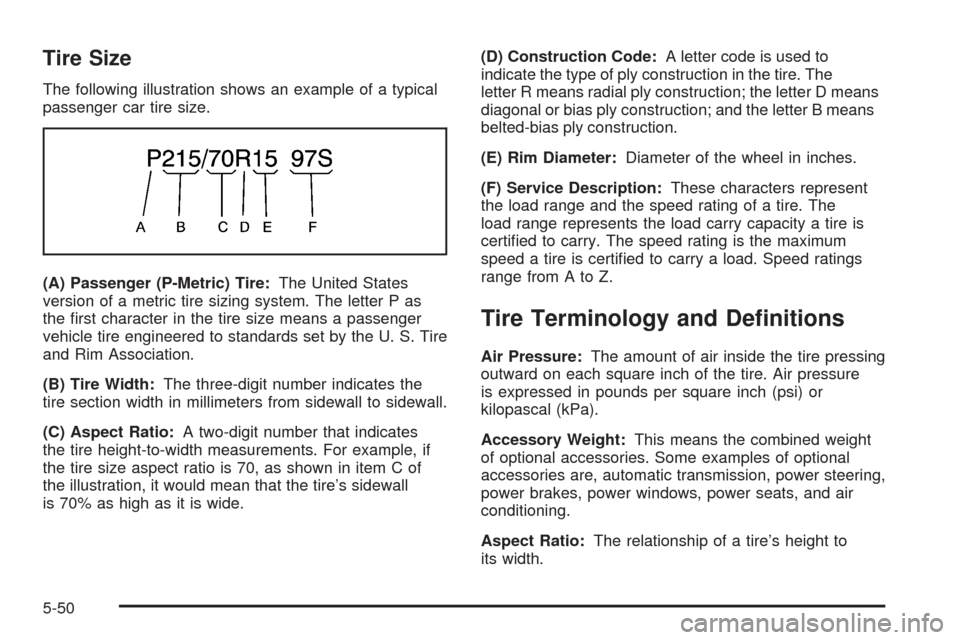
Tire Size
The following illustration shows an example of a typical
passenger car tire size.
(A) Passenger (P-Metric) Tire:The United States
version of a metric tire sizing system. The letter P as
the first character in the tire size means a passenger
vehicle tire engineered to standards set by the U. S. Tire
and Rim Association.
(B) Tire Width:The three-digit number indicates the
tire section width in millimeters from sidewall to sidewall.
(C) Aspect Ratio:A two-digit number that indicates
the tire height-to-width measurements. For example, if
the tire size aspect ratio is 70, as shown in item C of
the illustration, it would mean that the tire’s sidewall
is 70% as high as it is wide.(D) Construction Code:A letter code is used to
indicate the type of ply construction in the tire. The
letter R means radial ply construction; the letter D means
diagonal or bias ply construction; and the letter B means
belted-bias ply construction.
(E) Rim Diameter:Diameter of the wheel in inches.
(F) Service Description:These characters represent
the load range and the speed rating of a tire. The
load range represents the load carry capacity a tire is
certified to carry. The speed rating is the maximum
speed a tire is certified to carry a load. Speed ratings
range from A to Z.
Tire Terminology and De�nitions
Air Pressure:The amount of air inside the tire pressing
outward on each square inch of the tire. Air pressure
is expressed in pounds per square inch (psi) or
kilopascal (kPa).
Accessory Weight:This means the combined weight
of optional accessories. Some examples of optional
accessories are, automatic transmission, power steering,
power brakes, power windows, power seats, and air
conditioning.
Aspect Ratio:The relationship of a tire’s height to
its width.
5-50
Page 246 of 316
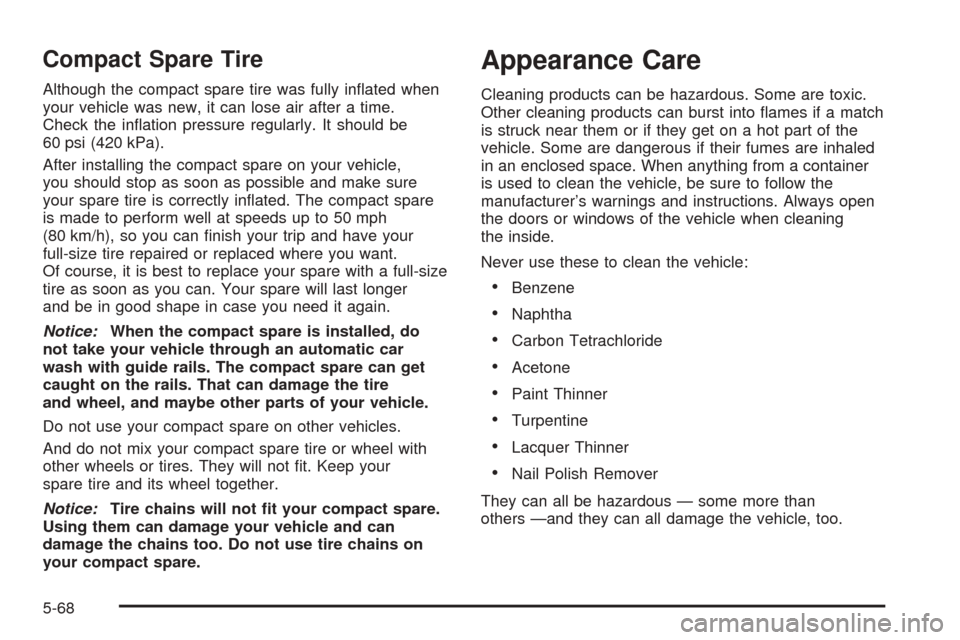
Compact Spare Tire
Although the compact spare tire was fully inflated when
your vehicle was new, it can lose air after a time.
Check the inflation pressure regularly. It should be
60 psi (420 kPa).
After installing the compact spare on your vehicle,
you should stop as soon as possible and make sure
your spare tire is correctly inflated. The compact spare
is made to perform well at speeds up to 50 mph
(80 km/h), so you can finish your trip and have your
full-size tire repaired or replaced where you want.
Of course, it is best to replace your spare with a full-size
tire as soon as you can. Your spare will last longer
and be in good shape in case you need it again.
Notice:When the compact spare is installed, do
not take your vehicle through an automatic car
wash with guide rails. The compact spare can get
caught on the rails. That can damage the tire
and wheel, and maybe other parts of your vehicle.
Do not use your compact spare on other vehicles.
And do not mix your compact spare tire or wheel with
other wheels or tires. They will not fit. Keep your
spare tire and its wheel together.
Notice:Tire chains will not �t your compact spare.
Using them can damage your vehicle and can
damage the chains too. Do not use tire chains on
your compact spare.
Appearance Care
Cleaning products can be hazardous. Some are toxic.
Other cleaning products can burst into flames if a match
is struck near them or if they get on a hot part of the
vehicle. Some are dangerous if their fumes are inhaled
in an enclosed space. When anything from a container
is used to clean the vehicle, be sure to follow the
manufacturer’s warnings and instructions. Always open
the doors or windows of the vehicle when cleaning
the inside.
Never use these to clean the vehicle:
•Benzene
•Naphtha
•Carbon Tetrachloride
•Acetone
•Paint Thinner
•Turpentine
•Lacquer Thinner
•Nail Polish Remover
They can all be hazardous — some more than
others —and they can all damage the vehicle, too.
5-68
Page 247 of 316

Do not use any of these products unless this manual
says you can. In many uses, these will damage
the vehicle:
•Alcohol
•Laundry Soap
•Bleach
•Reducing Agents
Cleaning the Inside of Your Vehicle
Your vehicle’s interior will continue to look its best if
it is cleaned often. Although not always visible, dust
and dirt can accumulate on your upholstery. Dirt
can damage carpet, fabric, leather, and plastic surfaces.
Regular vacuuming is recommended to remove
particles from your upholstery. It is important to keep
your upholstery from becoming and remaining heavily
soiled. Soils should be removed as quickly as possible.
Your vehicle’s interior may experience extremes of
heat that could cause stains to set rapidly.
Lighter colored interiors may require more frequent
cleaning. Use care because newspapers and garments
that transfer color to your home furnishings may also
transfer color to your vehicle’s interior.When cleaning your vehicle’s interior, only use
cleaners specifically designed for the surfaces being
cleaned. Permanent damage may result from using
cleaners on surfaces for which they were not intended.
Use glass cleaner only on glass. Remove any
accidental over-spray from other surfaces immediately.
To prevent over-spray, apply cleaner directly to the
cleaning cloth.
Notice:If you use abrasive cleaners when cleaning
glass surfaces on your vehicle, you could scratch
the glass and/or cause damage to the rear window
defogger. When cleaning the glass on your
vehicle, use only a soft cloth and glass cleaner.
Many cleaners contain solvents that may become
concentrated in your vehicle’s breathing space.
Before using cleaners, read and adhere to all safety
instructions on the label. While cleaning your vehicle’s
interior, maintain adequate ventilation by opening
your vehicle’s doors and windows.
Dust may be removed from small buttons and knobs
using a small brush with soft bristles.
Your GM dealer has a product for cleaning your
vehicle’s glass. Should it become necessary, you can
also obtain a product from your GM dealer to remove
odors from your vehicle’s upholstery.
5-69
Page 255 of 316
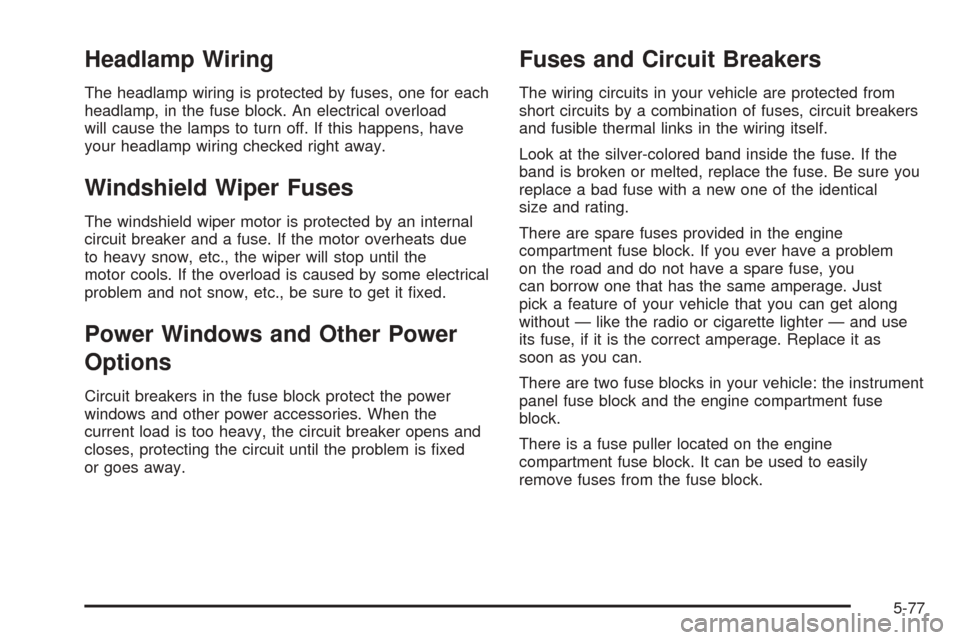
Headlamp Wiring
The headlamp wiring is protected by fuses, one for each
headlamp, in the fuse block. An electrical overload
will cause the lamps to turn off. If this happens, have
your headlamp wiring checked right away.
Windshield Wiper Fuses
The windshield wiper motor is protected by an internal
circuit breaker and a fuse. If the motor overheats due
to heavy snow, etc., the wiper will stop until the
motor cools. If the overload is caused by some electrical
problem and not snow, etc., be sure to get it fixed.
Power Windows and Other Power
Options
Circuit breakers in the fuse block protect the power
windows and other power accessories. When the
current load is too heavy, the circuit breaker opens and
closes, protecting the circuit until the problem is fixed
or goes away.
Fuses and Circuit Breakers
The wiring circuits in your vehicle are protected from
short circuits by a combination of fuses, circuit breakers
and fusible thermal links in the wiring itself.
Look at the silver-colored band inside the fuse. If the
band is broken or melted, replace the fuse. Be sure you
replace a bad fuse with a new one of the identical
size and rating.
There are spare fuses provided in the engine
compartment fuse block. If you ever have a problem
on the road and do not have a spare fuse, you
can borrow one that has the same amperage. Just
pick a feature of your vehicle that you can get along
without — like the radio or cigarette lighter — and use
its fuse, if it is the correct amperage. Replace it as
soon as you can.
There are two fuse blocks in your vehicle: the instrument
panel fuse block and the engine compartment fuse
block.
There is a fuse puller located on the engine
compartment fuse block. It can be used to easily
remove fuses from the fuse block.
5-77
Page 259 of 316
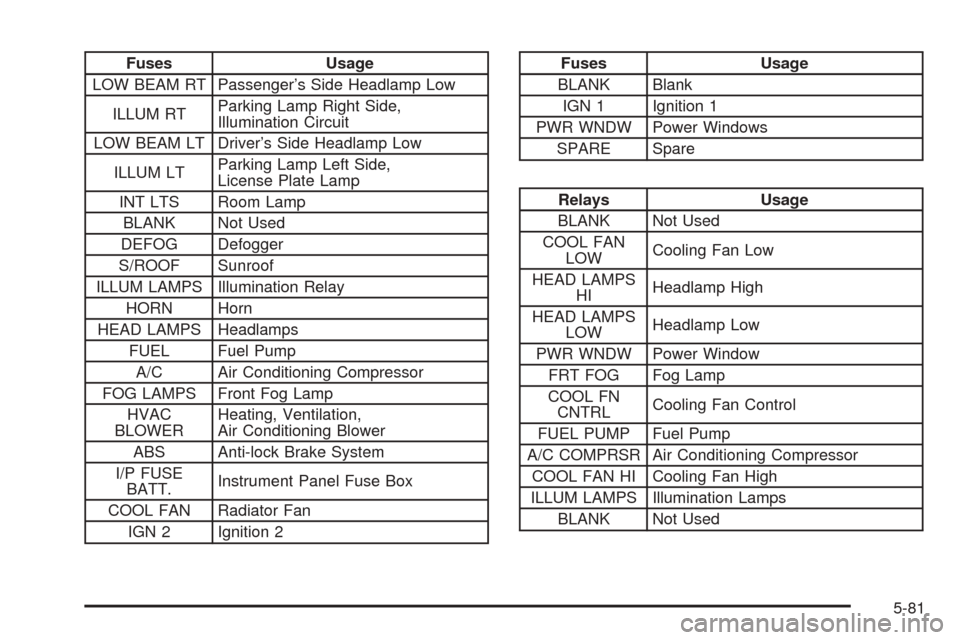
Fuses Usage
LOW BEAM RT Passenger’s Side Headlamp Low
ILLUM RTParking Lamp Right Side,
Illumination Circuit
LOW BEAM LT Driver’s Side Headlamp Low
ILLUM LTParking Lamp Left Side,
License Plate Lamp
INT LTS Room Lamp
BLANK Not Used
DEFOG Defogger
S/ROOF Sunroof
ILLUM LAMPS Illumination Relay
HORN Horn
HEAD LAMPS Headlamps
FUEL Fuel Pump
A/C Air Conditioning Compressor
FOG LAMPS Front Fog Lamp
HVAC
BLOWERHeating, Ventilation,
Air Conditioning Blower
ABS Anti-lock Brake System
I/P FUSE
BATT.Instrument Panel Fuse Box
COOL FAN Radiator Fan
IGN 2 Ignition 2Fuses Usage
BLANK Blank
IGN 1 Ignition 1
PWR WNDW Power Windows
SPARE Spare
Relays Usage
BLANK Not Used
COOL FAN
LOWCooling Fan Low
HEAD LAMPS
HIHeadlamp High
HEAD LAMPS
LOWHeadlamp Low
PWR WNDW Power Window
FRT FOG Fog Lamp
COOL FN
CNTRLCooling Fan Control
FUEL PUMP Fuel Pump
A/C COMPRSR Air Conditioning Compressor
COOL FAN HI Cooling Fan High
ILLUM LAMPS Illumination Lamps
BLANK Not Used
5-81
Page 308 of 316
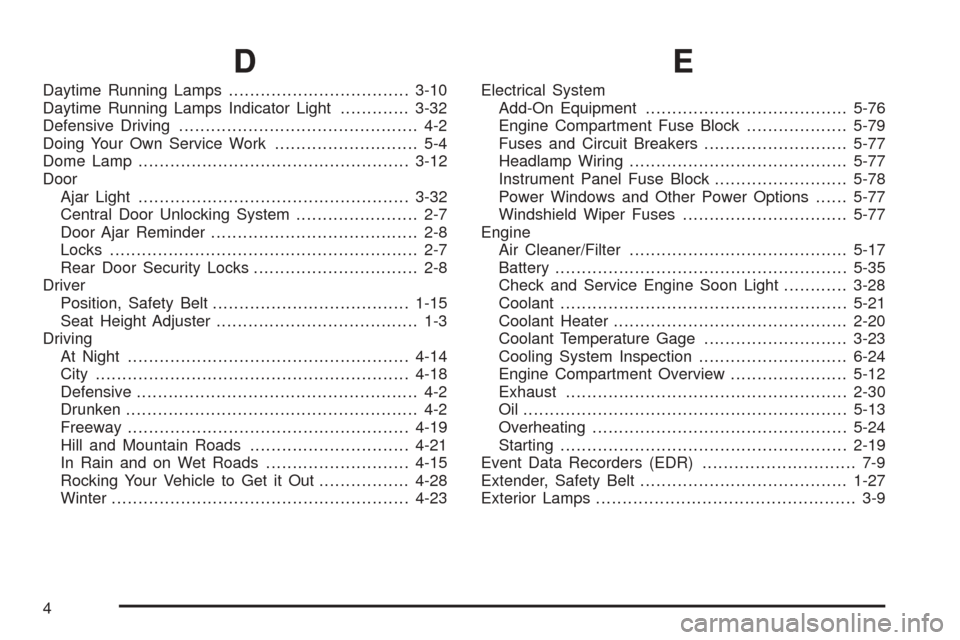
D
Daytime Running Lamps..................................3-10
Daytime Running Lamps Indicator Light.............3-32
Defensive Driving............................................. 4-2
Doing Your Own Service Work........................... 5-4
Dome Lamp...................................................3-12
Door
Ajar Light...................................................3-32
Central Door Unlocking System....................... 2-7
Door Ajar Reminder....................................... 2-8
Locks.......................................................... 2-7
Rear Door Security Locks............................... 2-8
Driver
Position, Safety Belt.....................................1-15
Seat Height Adjuster...................................... 1-3
Driving
At Night.....................................................4-14
City...........................................................4-18
Defensive..................................................... 4-2
Drunken....................................................... 4-2
Freeway.....................................................4-19
Hill and Mountain Roads..............................4-21
In Rain and on Wet Roads...........................4-15
Rocking Your Vehicle to Get it Out.................4-28
Winter........................................................4-23
E
Electrical System
Add-On Equipment......................................5-76
Engine Compartment Fuse Block...................5-79
Fuses and Circuit Breakers...........................5-77
Headlamp Wiring.........................................5-77
Instrument Panel Fuse Block.........................5-78
Power Windows and Other Power Options......5-77
Windshield Wiper Fuses...............................5-77
Engine
Air Cleaner/Filter.........................................5-17
Battery.......................................................5-35
Check and Service Engine Soon Light............3-28
Coolant......................................................5-21
Coolant Heater............................................2-20
Coolant Temperature Gage...........................3-23
Cooling System Inspection............................6-24
Engine Compartment Overview......................5-12
Exhaust.....................................................2-30
Oil .............................................................5-13
Overheating................................................5-24
Starting......................................................2-19
Event Data Recorders (EDR)............................. 7-9
Extender, Safety Belt.......................................1-27
Exterior Lamps................................................. 3-9
4
Page 312 of 316
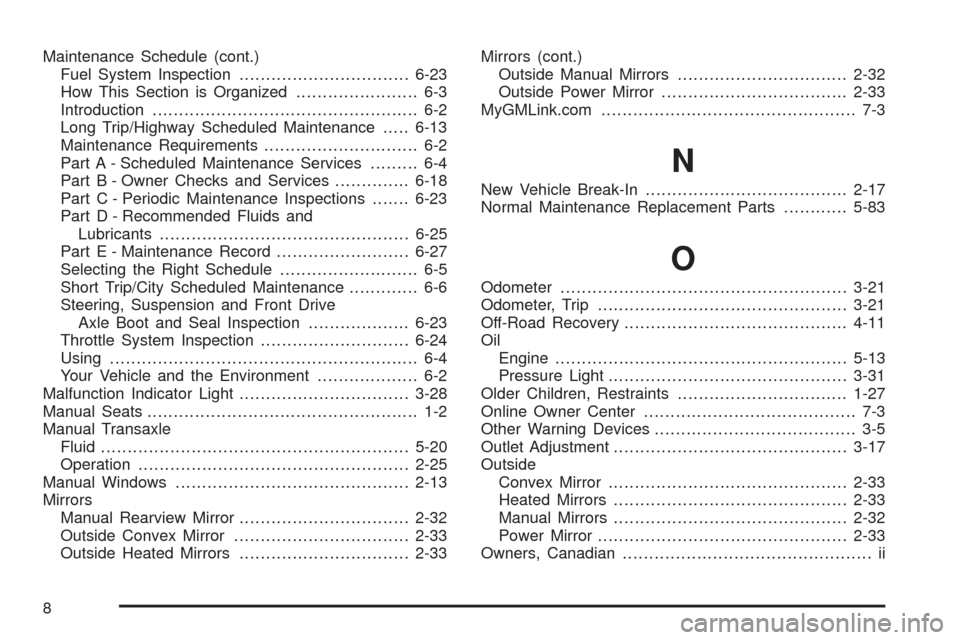
Maintenance Schedule (cont.)
Fuel System Inspection................................6-23
How This Section is Organized....................... 6-3
Introduction.................................................. 6-2
Long Trip/Highway Scheduled Maintenance.....6-13
Maintenance Requirements............................. 6-2
Part A - Scheduled Maintenance Services......... 6-4
Part B - Owner Checks and Services..............6-18
Part C - Periodic Maintenance Inspections.......6-23
Part D - Recommended Fluids and
Lubricants...............................................6-25
Part E - Maintenance Record.........................6-27
Selecting the Right Schedule.......................... 6-5
Short Trip/City Scheduled Maintenance............. 6-6
Steering, Suspension and Front Drive
Axle Boot and Seal Inspection...................6-23
Throttle System Inspection............................6-24
Using.......................................................... 6-4
Your Vehicle and the Environment................... 6-2
Malfunction Indicator Light................................3-28
Manual Seats................................................... 1-2
Manual Transaxle
Fluid..........................................................5-20
Operation...................................................2-25
Manual Windows............................................2-13
Mirrors
Manual Rearview Mirror................................2-32
Outside Convex Mirror.................................2-33
Outside Heated Mirrors................................2-33Mirrors (cont.)
Outside Manual Mirrors................................2-32
Outside Power Mirror...................................2-33
MyGMLink.com................................................ 7-3
N
New Vehicle Break-In......................................2-17
Normal Maintenance Replacement Parts............5-83
O
Odometer......................................................3-21
Odometer, Trip...............................................3-21
Off-Road Recovery..........................................4-11
Oil
Engine.......................................................5-13
Pressure Light.............................................3-31
Older Children, Restraints................................1-27
Online Owner Center........................................ 7-3
Other Warning Devices...................................... 3-5
Outlet Adjustment............................................3-17
Outside
Convex Mirror.............................................2-33
Heated Mirrors............................................2-33
Manual Mirrors............................................2-32
Power Mirror...............................................2-33
Owners, Canadian............................................... ii
8
Page 313 of 316
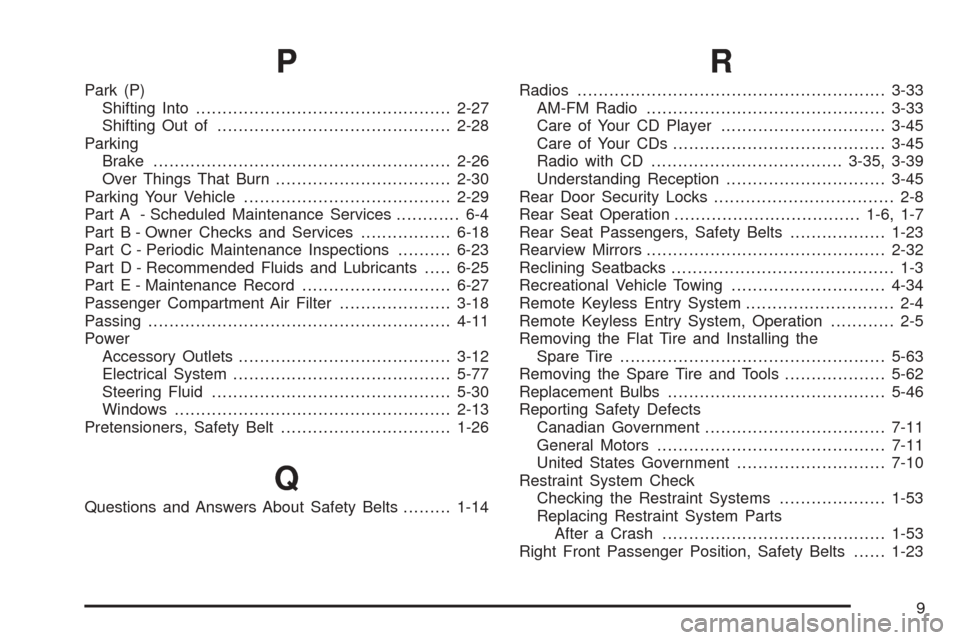
P
Park (P)
Shifting Into................................................2-27
Shifting Out of............................................2-28
Parking
Brake........................................................2-26
Over Things That Burn.................................2-30
Parking Your Vehicle.......................................2-29
Part A - Scheduled Maintenance Services............ 6-4
Part B - Owner Checks and Services.................6-18
Part C - Periodic Maintenance Inspections..........6-23
Part D - Recommended Fluids and Lubricants.....6-25
Part E - Maintenance Record............................6-27
Passenger Compartment Air Filter.....................3-18
Passing.........................................................4-11
Power
Accessory Outlets........................................3-12
Electrical System.........................................5-77
Steering Fluid.............................................5-30
Windows....................................................2-13
Pretensioners, Safety Belt................................1-26
Q
Questions and Answers About Safety Belts.........1-14
R
Radios..........................................................3-33
AM-FM Radio.............................................3-33
Care of Your CD Player...............................3-45
Care of Your CDs........................................3-45
Radio with CD....................................3-35, 3-39
Understanding Reception..............................3-45
Rear Door Security Locks.................................. 2-8
Rear Seat Operation...................................1-6, 1-7
Rear Seat Passengers, Safety Belts..................1-23
Rearview Mirrors.............................................2-32
Reclining Seatbacks.......................................... 1-3
Recreational Vehicle Towing.............................4-34
Remote Keyless Entry System............................ 2-4
Remote Keyless Entry System, Operation............ 2-5
Removing the Flat Tire and Installing the
Spare Tire..................................................5-63
Removing the Spare Tire and Tools...................5-62
Replacement Bulbs.........................................5-46
Reporting Safety Defects
Canadian Government..................................7-11
General Motors...........................................7-11
United States Government............................7-10
Restraint System Check
Checking the Restraint Systems....................1-53
Replacing Restraint System Parts
After a Crash..........................................1-53
Right Front Passenger Position, Safety Belts......1-23
9